- Home
- About
- Knowledge Center
- Legislative Landscape
- Resources
- #TOGETHERFORBHARA
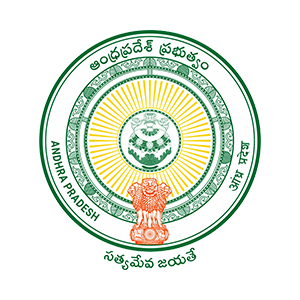
On the occasion of the 2,500th Buddha Jayanthi, Andhra Pradesh adopted a Poornaghatam of Amaravati stupa, an Ashoka chakra, and four lion heads as its official emblem in 1956. A sun radiant encased in an ornamented circular frame, charged with a treasure vase, the crest of the Republic of Bharat appears at the bottom. The state’s name, “Government of Andhra Pradesh,” is in both Hindi and Telugu, with the Bharatiya national motto, “Satyameva Jayate,” written in Devanagari at the bottom.
The Sun rises between the peaks of Komdi and Daphabum above a Mithun bison head, supported by two Hornbills, with the Emblem of Bharat forming the crest. Arunachal Pradesh’s official state animals and birds are the Mithun bison and hornbill, and mountains and sunrise allude to the state’s name, which translates as “the land of dawn-lit mountains.”

At the moment, the Bharatiya state of Assam does not have a distinctive government emblem and instead uses the national emblem of Bharat with the words “Oxom Sorkar” above and “Government of Assam” below. In February 2022, the Assam government decided to form a committee to consider the design of a distinctive state emblem.
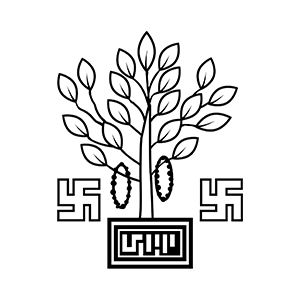
Bihar’s state emblem depicts the Bodhi Tree with Prayer Beads flanked by two swastikas. In fact, the base of the tree is brick with بہار, Urdu for “Bihar,” inscribed on it.
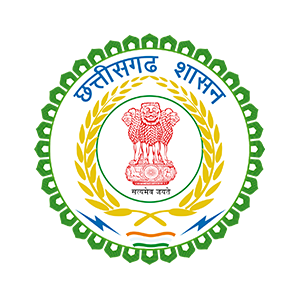
The emblem is a circular seal with the Lion Capital of Ashoka surrounded by rice ears. Below the capital are three wavy lines in Bharatiya national flag colours representing the state’s rivers, flanked by two lightning bolts representing Energy Surplus State. The entire emblem is surrounded by 36 fortifications representing the 36 fortresses named after the state. It was adopted on September 4, 2001, when the state of Chhattisgarh was formed from a portion of Madhya Pradesh.
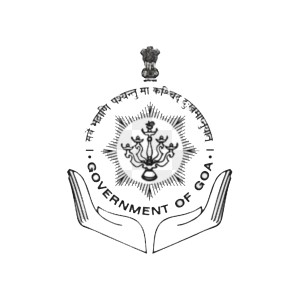
In the centre of the emblem is a “Vriksha Deep,” a type of diya lamp. The lamp symbolises enlightenment through knowledge and is surrounded by a stylized design of coconut leaves, representing Goa’s abundant and beautiful aspects. A Sanskrit motto appears above the lamp and can be translated as “may everyone see goodness, may none suffer pain” (Devnagari: सर्वे भद्राणि पश्यन्तु मा कश्चिद् दुःखमाप्नुयात्). The arms are supported by two open hands and the National Emblem of Bharat, the Lions of Sarnath.

The State Emblem of Gujarat is the Republic of Bharat’s national emblem. Many state governments, other government agencies, and the union government use it. The emblem is based on the Lion Capital of Ashoka, an ancient Maurya Empire sculpture dating back to 280 BCE. The statue is a three-dimensional representation of four lions. On December 30, 1947, following the end of British rule on August 15, 1947, the newly independent of Bharat adopted an official state emblem. It represented Ashoka’s Lion Capital at Sarnath, enclosed within a rectangular frame.
The State Emblem of Bharat was adopted on January 26, 1950, with a representation of the Lion Capital of Ashoka placed above the motto, Satyameva Jayate.

A circular shield depicting a lotus blossom emerging from water in front of a rising sun serves as the emblem. The shield is supported by wheat ears, and the crest is the Lion Capital of Ashoka.
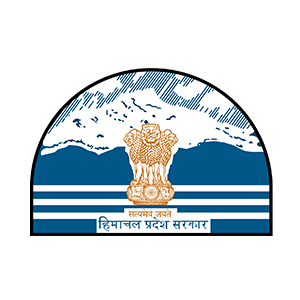
The Emblem of Himachal Pradesh is the official state seal used by the Government of Himachal Pradesh and is carried on all official correspondences made by the State of Himachal Pradesh. It was adopted by the Government of Himachal Pradesh at the establishment of the state on 25 January 1971. The State of Himachal Pradesh has an Emblem consisting of a mountain ridge over three white fesses, charged with the Aśoka capital.
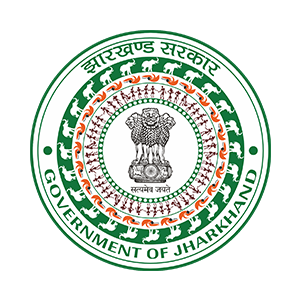
Jharkhand’s first emblem was adopted on November 15, 2000, when the state of Jharkhand was formed from the southern part of Bihar. This emblem featured an Ashoka Chakra, as seen on the Bharatiya national flag, surrounded by four-letter Js stylised as daggers. The legend underneath, Jharkhand Sarkar, translates as Government of Jharkhand.
On July 22, a new emblem was officially approved for use beginning August 15, 2020. It consists of multiple rings, with elephants (the state animal) in the outer ring representing strength, wildlife, royalty, and lush vegetation. The middle ring features Palash flowers (the state flower), also known as “flames of the jungle,” representing rich flora, beauty, and culture. The inner ring is composed of people painted in the distinctive Jharkhandi style, representing the rich history and strength of social bonds. The Lion Capital of Ashoka is at the centre, with the motto Satyameva Jayate.

The emblem is a red shield bordered in blue with a white two-headed bird, Gandabherunda (a two-headed bird in Hindu mythology). The Lion Capital of Ashoka (also used as the Government of Bharat’s emblem) is depicted on a blue circular abacus with a blue frieze carrying sculptures in high relief of a galloping horse on the left, a Dharmachakra in the centre, a bull on the right, and the outlines of Dharmachakras on the extreme left and right as part of Sarnath’s Ashoka Pillar.
A red-maned, yellow lion-elephant flank the shield on either side, indicating the auspicious mythological character ‘Gajakesari,’ a hybrid form of two wise and powerful animals, Lion and Elephant – a mythical creature believed to be auspicious, representing strength, authority, and intelligence. The power of Gajakesari is thought to uphold greater righteousness and bring abundance and bliss. In Hindu astrology, it also refers to the fortunate momentum or energy.
According to Hindu belief, a person with ‘Gajakesari Yoga’ in his astrology chart is conquering the world, same referring to a kingdom that justifies all characteristics of a conqueror) standing on a green, leafy compartment. Below the compartment, lies written in stylised Devanagari, the national motto of Bharat, “सत्यमेव जयते” (Satyameva Jayate, Sanskrit for “Truth alone triumphs”)
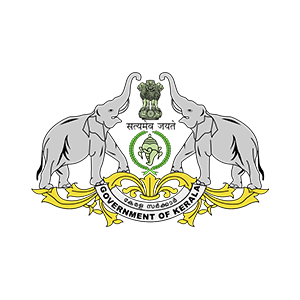
The official Kerala emblem is a modified version of the Kingdom of Travancore’s Royal coat of arms. The state emblem depicts two elephants guarding the Bharatiya state emblem and the Travancore Kingdom emblem (a doubly-coiled silver conch shell (Turbinella pyrum)). Kerala’s current emblem was adopted in 1960, when Pattom A. Thanu Pillai’s government took power following the removal of the communist government by the Bharatiya Central Government.
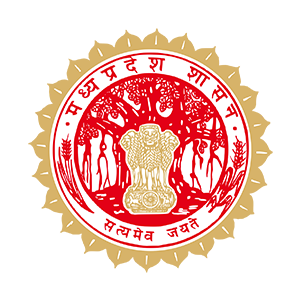
The emblem is a circular seal depicting the Lion Capital of Ashoka in front of a banyan tree. The Lion Capital and tree are supported by stalks of wheat and rice and the whole emblem is surrounded by 24 stupas figures.
The emblem is a circular seal depicting a Samai Diya lamp surrounded by 16 lotus blossoms. Between the Samai lamp and lotus blossoms is a motto in Sanskrit, प्रतिपच्चंद्रलेखेव वर्धिष्णुर्विश्व वंदिता महाराष्ट्रस्य राज्यस्य मुद्रा भद्राय राजते, (Pratipaccandralēkhēva vardhiṣṇurviśva vanditā mahārāṣṭrasya rājyasya mudrā bhadrāya rājatē), which translates as “The glory of this seal of the State Government of Maharashtra will grow like the first-day moon. It will be worshipped by the world and will shine only for the well-being of its people”. The motto is based on one found on the “Rajmudra” (royal seal) used by 17th-century Maratha king Chhatrapati Shivaji, the only difference being that the name of the state replaces the name of the monarch.

The emblem features a Kanglasha, a mythological creature that is half-lion and half-dragon. It was officially adopted by the state government on 18 December 1980.

The current emblem was adopted on 19 January 2022 as part of the state’s golden jubilee celebrations. The design by P. Mario K. Pathaw was chosen following a state-wide competition that attracted 198 entries. Previously the state used a seal based on the emblem of Bharat for official purposes. The emblem is a circular seal depicting the following features:

The State Emblem of Bharat is the national emblem of the Republic of Bharat and is used by the union government, many state governments, and other government agencies. The emblem is an adaptation of the Lion Capital of Ashoka, an ancient sculpture dating back to 280 BCE during the Maurya Empire. The statue is a three-dimensional emblem showing four lions. Following the end of British rule on 15 August 1947, the newly independent of Bharat adopted an official state emblem on 30 December 1947. The emblem represented the Lion Capital of Ashoka at Sarnath, enclosed within a rectangular frame.
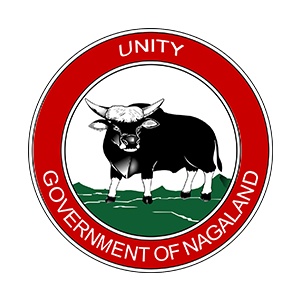
The emblem of Nagaland is a circular seal depicting a Mithun bison standing on a green hilly landscape, surrounded by the motto “Unity” and the words “Government of Nagaland”. It was designed by local artist Merimvü Doulo and was officially adopted in August 2005.

The emblem is a circular seal depicting a representation of the Warrior and Horse statue found at the Konark Sun Temple. The crest of the emblem is the Lion Capital of Ashoka. On 3 August 1964, the Council of Ministers adopted the design of the Konark Horse statue as the State Emblem. It symbolises discipline, strength and progress.

Punjab’s emblem is an encircled Lion Capital of Ashoka (representing ancient Ashoka-era heritage discovered at Sanghol), with a Wheat stem above it and crossed Swords below it. The legend “Government of Punjab” is written around the lion capital in English, Hindi, and Punjabi.

Rajasthan’s emblem incorporates the Bharatiya State Emblem. Along with it, the words “Satyameva Jayate” (Truth Alone Triumphs) and “Government of Rajasthan” are written beneath it.
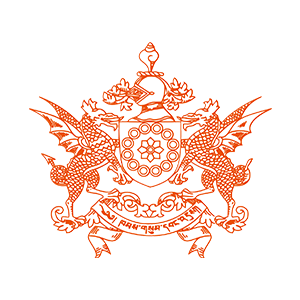
The Emblem of Sikkim is currently used as the official seal of the Government of Sikkim, Bharat. It was earlier used as the coat of arms of the House of Namgyal and the Kingdom of Sikkim. The Kham-sum-wangdu is the name given to the emblem. It was designed in 1877 by Robert Taylor. The blazon consists of a lotus within a chain of 12 annulets, symbolising purity and a lotus showcasing the attainment of enlightenment. It is also a symbol of administrative power. Lotus thrones are the pedestal for the most influential figures in Buddhist art.

The state emblem was designed in 1949 by artist R. Krishna Rao, a native of Madurai. It consists of the Lion Capital of Ashoka without the bell lotus foundation and flanked on either side by an Bharatiya flag. Behind the capital is the image of a Gopuram, or temple tower based on the Srivalliputhur Temple. Around the rim of the seal runs an inscription in Tamil script, one at the top தமிழ் நாடு அரசு (“Tamil Nadu Arasu” which translates to “Government of Tamil Nadu”) and the other at the bottom வாய்மையே வெல்லும் (“Vaymaiye Vellum” which translates to “Truth Alone Triumphs” also commonly known as “Satyameva Jayate” in Sanskrit). It is the only state emblem with the Bharatiya Flag and Hindu temple tower on its seal.
Although the gopuram in the emblem is generic, specific references to the Srivilliputhur Andal temple tower (gopuram) came to be known as the state emblem, even in government records due to the TKC-Reddy episode. But R Krishna Rao, the artist who created it, said he had the Madurai Meenakshi Temple’s west ‘gopuram’ in mind while designing a generic `gopuram’ for the emblem. A monograph on Rao, published by the Lalit Kala Akademi, quotes him as saying, “Hailing from Madurai, it was only proper that I should incorporate the Madurai temple in the state government’s emblem.”
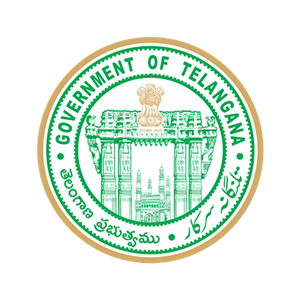
The Emblem of Telangana is the state emblem of Telangana in South Bharat. The emblem is a circular seal consisting of the Kakatiya Kala Thoranam and Charminar with the Sarnath Lion Capital above. It has “Government of Telangana” in English, “Telangana Sarkar” in Urdu and “Telangana Prabhutvamu” in Telugu. Satyameva Jayate is written in Sanskrit.
Painter Laxman Aelay designed the emblem. It was adopted on 2 June 2014 after the newly formed government headed by K. Chandrashekar Rao adopted it. It was the first file to be signed by him after swearing-in. Initially, Charminar was not included, but after the advice of Asaduddin Owaisi, (Hyderabad MP), it was added.
Initially, the national motto was written below the emblem. Naresh Kadyan, Abhishek Kadyan, and Sukanya Kadyan complained to the government about the alleged insult of the emblem without the motto. The Sarnath Lion Capital, when used in heraldry, is required to have the words Satyameva Jayate underneath it, as per the State Emblem of Bharat (Prohibition of Improver Use) Act, 2005, which the new logo violated when it was first released. The emblem was corrected with an amendment approved by the Government of Telangana on 25 June 2014 made by Laxman Aelay, by moving the Satyameva Jayate below the Sarnath Lion Capital, complying with the national norm.

The emblem of Tripura consists of the Lion Capital of Ashoka (depicting ancient Ashoka-era heritage found at Sanghol) with the motto in Devanagari, “सत्यमेव जयते” (Satyameva Jayate, Sanskrit for “Truth Alone Triumphs”).

The emblem was created in 1916 for the then-United Provinces of Agra and Oudh, and it has remained in use since Bharatiya independence in 1947. It consists of a seal depicting the confluence of the Ganga and Yamuna rivers at Prayagraj, a pair of Matsya, mythical Avatar creatures from Hindu mythology to represent the state of Oudh (Awadh), and a pair of Bow and Arrow representing Lord Rama and his city of Ayodhya, the region’s ancient and cultural capital.
The legend around the seal translates as “Government of Uttar Pradesh.”

The Emblem of Uttarakhand is the official state seal used by the Government of Uttarakhand and is carried on all official correspondences made by the State of Uttarakhand. It was adopted by the newly formed Interim Government of Uttarakhand at the establishment of the state on 9 November 2000.
The Emblem of Uttarakhand is a diamond-shaped emblem with white background and blue borders supported by the stylised mountain peaks of the Himalayas with four streams charging from left to right. The red background on the top represents the blood of statehood activists who lost their lives during the course of the Uttarakhand statehood movement, while the white background represents the peaceful nature of the Uttarakhandi people. The mountains represent the Himalayan state’s geography and ecology, and the four streams represent the Ganga. The blue colour symbolises the purity of water attributed to the holy rivers of Uttarakhand.
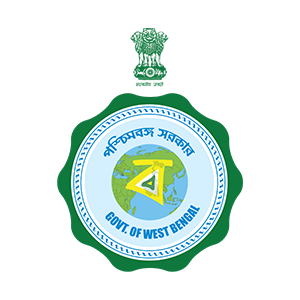
The emblem consists of a circle depicting a globe with the state of West Bengal highlighted by a representation of the Bengali alphabet. The National Emblem of Bharat appears above the globe, and the emblem includes the name of the state in English i.e., West Bengal, and in the Bengali language, i.e., Bengali: পশ্চিমবঙ্গ, romanized: Pôśchim Bôṅgô. The central element of the emblem was also used by the Biswa Bangla campaign to promote the sale of traditional West Bengali handicrafts and textiles.
The current emblem was designed by Mamata Banerjee, the state’s Chief Minister and was officially adopted in January 2018. Prior to the adoption of the new emblem in 2018, the state government used the National Emblem of Bharat for official purposes but had adopted a distinctive logo for marketing purposes. This logo, “Banglarmukh” (Face of Bengal), depicted a female face surrounded by a red veil.
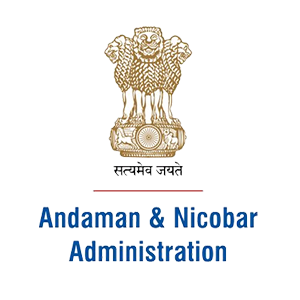
The State Emblem of Bharat is the official seal of the government of the Bharatiya union territory of the Andaman and Nicobar Islands. The emblem is an adaptation of the Lion Capital of Ashoka, an ancient sculpture dating back to 280 BCE during the Maurya Empire. The statue is a three-dimensional emblem showing four lions. It became the emblem of Bharat in December 1947 and later the emblem of the Republic of Bharat.
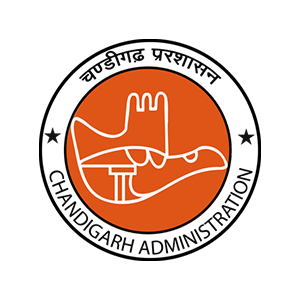
The Emblem of Chandigarh is the official seal of the government of the Bharatiya union territory of Chandigarh. It consists of a circular shield depicting a representation of Le Corbusier’s Open Hand Monument sculpture which is widely regarded as a symbol of the city of Chandigarh.

Dadra and Nagar Haveli and Daman and Diu use the National Emblem of Bharat.
Delhi uses the National Emblem of Bharat.
Jammu and Kashmir uses the National Emblem of Bharat.
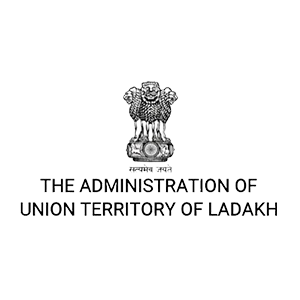
Ladakh uses the National Emblem of Bharat.
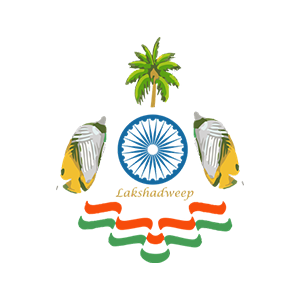
The emblem depicts an Ashoka Chakra, behind which there is a palm tree which is flanked by two butterflyfish and below is a compartment of ribbons in the colours of the Bharatiya flag.
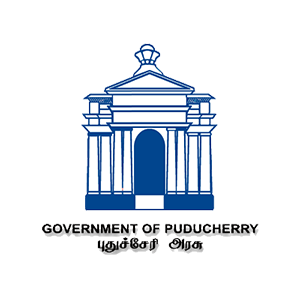
Puducherry’s emblem consists of Aayi Mandapam (Park Monument), a white monument in Puducherry, Bharat. Built during the time of Napoleon III, Emperor of France. It is situated in the center of Bharati Park. The monument commemorates the provision of water to the French city during his reign. It was named after a lady courtesan named Āyi, who, in fact, destroyed her own house to erect a water reservoir to supply water for the city.